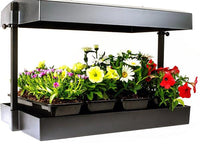Knowing which types of grow lights you need for your indoor plants is tricky business. It’s not only beginners who get confused. Novice growers get mixed up as well when reading up on all the different types on the market.
We feel like it’s our obligation to make this journey a little less of a chore…
… or maybe a little less of the wild goose chase it normally is.
We’ve gathered a ton of info and put it all in one convenient place, just a couple of inches below this sentence.
Don’t pull your hair out. If you have any questions at all about the different types of grow lights and light accessories, feel free to call or text us:

LED Grow Lights
Pro: Energy Efficient
LED grow lights are the most versatile and cost effective out of all of the different types of grow lights. The upfront costs are the highest. However, if you can spring the green, they will save you a lot of money in electric bills. They are highly efficient and don’t normally require cooling equipment, exhaust fans, and reflector hoods. They have a much higher lifespan, too, than other grow lights.
Pro: No Need for Cooling Technology
You don’t have to worry too much about whether you’ll fry your indoor plants because they’re too close to them. Heat burn won’t be an issue. You still want to be careful about light burn. You can avoid light burn easily by keeping your LED lights at least 12 inches away from the plants.
Pro: Full-Spectrum Light You Can Customize as Your Grow Matures
Good quality LED lights provide a full spectrum of light that you can adjust as you go along. Some color frequencies are better for the vegetative stage. Others are better for the flowering stage. Some strains may prefer certain combinations of light frequencies over others.
Pro: Less Bulky, Allowing for a Compact Grow in a Smaller Indoor Space
Do you have a tiny indoor grow room or grow tent? No problem. LED systems are smaller than other systems in proportion to their footprint sizes. The low risk of heat burn allows you to move them in closer, too.
Con: Extreme Temperatures Can Make LEDs Quirky
LED lights are sensitive to extreme hot and extreme cold. This can affect how they function and cause hiccups now and then.
Con: Higher Upfront Cost
As mentioned above, the initial costs are usually on the higher end. The savings in electricity are long-term.

LED Grow Light Brands We Carry at Grow Supply Shop
- Grower’s Choice – They are known for top-tier quality control and for designing grow lights that pass high lab test standards.
- KIND LED – KIND employs cutting edge researchers to produce cutting edge products. They minimize the harmful and inefficient green and yellow light that comes from typical white light systems and maximize the most beneficial light frequencies for your indoor plants.
- Horticulture Lighting Group (HLG) – HLG is best known for their super high efficiency Quantum Board® “light engines.”
- Photobio – They are best known for systems that ensure a uniform distribution of photons to your canopy. This means consistent light intensity across each grow light’s entire footprint.
Browse LED Grow Lights from Grow Supply Shop
Metal-Halide (MH) Grow Lights
Pro: Grow Lights Don’t Get Cheaper Than These
Non-ceramic MH lights are basically the cheapest lights you can get. However, the price differences between the different types of grow lights are shrinking as time passes.
Pro: Higher Intensity Than LED Lights
Metal-Halide lights produce intense white light by combusting flammable gases. The light is very intense compared to what LEDs and incandescent bulbs emit per Watt. It penetrates canopies well and tends to favor larger grows.
Con: Lower Energy Efficiency & Higher Electric Bills Than LED
Metal-Halide and High-Pressure Sodium (HPS) grow lights both belong to a category called High-Intensity Discharge (HID) lights. HIDs generally cost less than LED lights in the short term. However, they cost more to run.
There are some Ceramic Metal-Halide (CMH) grow lights that are exceptions to this rule. There is a CMH section below if you scroll down. They get their own section because they’re exceptions to other rules, too.
Con: They Get Pretty Hot
The higher heat generation usually means there’s more hot air to get rid of. That will jack up your electric bill even more.
Con: They’re Bulky
This is not the type of grow light you want for stealth indoor grow rooms and small grow tents if you have a choice in the matter.
Con: Inflexible Light Spectrum That Favors Vegetative Stage
Unlike LED lights, you cannot control the color frequencies your MH light will emit.
On the other hand, the white light mimics natural light pretty well. It’s also very intense, so you can be sure your indoor plants will get plenty of light.
Overall, MH lights are better suited for the vegetative stage than for flowering. This is because they don’t produce much red light, which encourages stronger branches.
Con: They Gradually Become Useless as Grow Lights
MH lights degrade over time and become less effective as grow lights. If the lifespan of a bulb is 20,000 hours, they may become unusable long before the 20,000 hours are used up.
Con: Compatible Ballast & Reflector Required
An MH light needs to be accompanied by a ballast that is compatible with the wattage of the light. It also needs some type of reflector.
Pro: Impervious to Surrounding Air Temperature
The functions of MH lights are independent of the surrounding air temperature. This gives them an advantage over LED lights, which can have a harder time running properly in very hot or very cold temperatures.
High-Pressure Sodium (HPS) Grow Lights
Pro: Cheaper Than LEDs
HPS and MH systems are “old school” and tend to be the cheapest types of grow lights to buy.
Con: Higher Electric Bills Than LED
This type of grow light may be cheaper to buy than most others, but you won’t like the electric bill.
Con: Inflexible Light Spectrum That Favors Flowering Stage
HPS lights favor the flowering stage because they emit a lot of light at the red end of the spectrum. Unlike LED systems, you can’t dial your desired combo of color frequencies.
The old school routine, before LED grow lights and CMHs, was to use MH lights during the vegetative stage and HPS lights during the flowering stage. Some growers would run both types of lights during both stages for a “full-spectrum” effect.
If growers had to choose only one light type to use for both stages, they usually opted for HPS lights or a combo of HPS and fluorescent bulbs. The fluorescents, like MHs, have a lot of blue light that favors vegetation.
Con: Usually Contains Mercury
HPS and MH lights both heat up gases inside the bulbs. In HPS bulbs, the gas is usually mercury, which is toxic to humans, pets, and other lifeforms. MH bulbs may contain mercury or other gases.
Recommended HPS Grow Lights
The HPS brand we carry at Grow Supply Shop is Grower’s Choice. They create grow lights that pass stringent laboratory tests. Their defect rate is also less than 0.1%. All of their grow lights are ETL listed and NRC licensed in the USA.
Browse Grower’s Choice HPS Lights
Ceramic Metal Halide (CMH) Grow Lights
These lights are sometimes called Light Emitting Ceramics (LEC). Their functionality is similar to MH lights, but they have ceramic tubes instead of quartz tubes. This makes a huge difference in efficiency and quality.
You can think of a CMH light as a combination of an HPS and an MH in one bulb. This makes it an excellent choice for both the veg and flower stages. The biggest difference is that it emits a more “natural” sunlight-like light than the HPS/MH combo.
Pro: Energy Efficiency Can Be Higher Than Some LED Systems
CMH lights are far more energy efficient than MH lights, but they cost a little more. They provide a lot more value for the extra money. A good CMH system’s energy efficiency may even rival that of some LED grow light systems.
Pro: Nearly Full-Spectrum
CMHs also emit, pretty much, a full spectrum of color. They provide a lot of red and blue. Red is great for flowering, and blue is great for the vegetative stage. Overall, CMH light is closer to natural sunlight than MH light.
Pro: Less Heat Than MH
CMHs run cooler than MH lights.
Pro & Con: Lifespan Longer Than MH, Much Shorter Than LED
The lifespan of a CMH is significantly longer that that of an MH. An LED lifespan will dwarf both.
Con: Requires a Ballast
Like a standard MH light, a CMH will need to be paired with a compatible ballast. However, if you buy your CMH lights as kits, systems, or fixtures, then you’re covered with everything you need.
Recommended CMH Grow Lights
Again…
The CMH brand we carry at Grow Supply Shop is Grower’s Choice. They create grow lights that pass stringent laboratory tests. Their defect rate is also less than 0.1%. All of their grow lights are ETL listed and NRC licensed in the USA.
Browse Grower’s Choice CMH Lights
Fluorescent Grow Lights
Con: Inflexible Spectrum That Tends Toward the Blue End
Like MH lights, fluorescent grow lights produce a lot of blue light.
Con: Very Low Efficiency
The largest difference between fluorescent and MH is efficiency. MHs put out a lot more light per Watt.
Con: Not Enough Light for Adult Plants
Fluorescents are fine for young indoor plants and for cloning, but not for much else. Even if you have a small indoor grow room, you’ll probably want a system with more power after the plants mature into adulthood.










